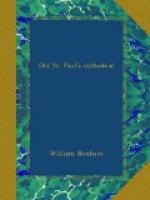This cathedral was wonderfully rich in plate and jewels, so much so that, as Dugdale says, the very inventory would fill a volume. To take only one illustration: King John of France when he was brought here by the Black Prince “gave an oblation of twelve nobles at the shrine of St. Erkenwald, the same at that of the Annunciation, twenty-six floren nobles at the Crucifix by the north door, four basins of gold at the high altar; and, at the hearing of Mass, after the Offertory, gave to the Dean then officiating, five floren nobles, which the said Dean and John Lyllington (the weekly petty canon), his assistant, had. All which being performed, he gave, moreover, in the chapter-house, fifty floren nobles to be distributed amongst the officers of the church.”
With regard to the character of the services before the Reformation, we have but few data to go upon. In 1414 Bishop Richard Clifford, with the consent of the Dean and Chapter, ordained that from the first day of December following, the use of Sarum should be observed. Up to that time there had been a special “Usus Sancti Pauli.”
There was an organ in the church, or rather, to use the old phrase, a “pair of organs,” for the instrument had a plural name like “a pair of bellows.” Organs were in use in the church at any rate in the fourth century, and were introduced into England by Archbishop Theodore. In old times there was no official organist; the duty was taken by the master of the choristers or one of the gentlemen of the choir. In churches of the regular foundation a monk played.
English Church music, in its proper sense, began with the Reformation. In the Roman Church, the great genius of Palestrina had produced nothing less than a revolution as regards the ancient Plain Song; and with the English Liturgy we associate the honoured names of Tallis, Merbecke, Byrd, Farrant in the early days, and a splendid list of successors right down to our time, wherein is still no falling off. Tallis is supposed by Rimbault to have been a pupil of Mulliner, the organist of St. Paul’s, but there is no evidence to support this. It must be confessed that his service in the Dorian mode, which heads the collection in Boyce’s Cathedral Music, and which is indeed the first harmonised setting of the Canticles ever composed for the English Liturgy, is very dull, but his harmony of the Litany and of the Versicles after the Creed, has never been equalled for beauty. His Canon tune, to which we sing Ken’s Evening Hymn, is also unsurpassed, and his anthem, “If ye love Me,” is one of wonderful sweetness and devout feeling. John Redford was his contemporary, and was organist of St. Paul’s, 1530-1540. His anthem, “Rejoice in the Lord,” is as impressive and stately as Tallis’s that I have just named. It is frequently sung at St. Paul’s still. William Byrd was senior chorister of St. Paul’s in 1554. I hold his service in D minor to be the finest which had as yet been set to the Reformed Liturgy—the




